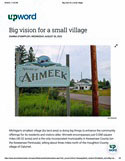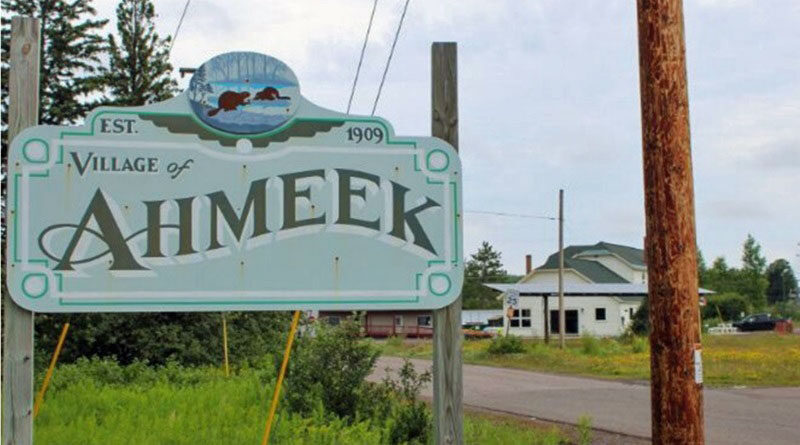Big vision for a small village

By Dianna Stampfler
Michigan’s smallest village (by land area) is doing big things to enhance the community offerings for its residents and visitors alike. Ahmeek encompasses just 0.068 square miles (45.52 acres) and is the only incorporated municipality in Keweenaw County (on the Keweenaw Peninsula), sitting about three miles north of the Houghton County village of Calumet.
Ahmeek’s Early History
While the Ahmeek Mining Company operations began in this area around 1880—as an exploration wing of the Seneca Mining Company—it would be more than two decades before Joseph Bosch of the Bosch Brewing Company founded the village of Ahmeek in 1904. Its name comes from the Ojibwe word “amik” meaning “beaver” which once inhabited the area in great numbers.
A post office was established here in February 1909, with attorney James A. Hamilton serving as the first postmaster. That April, a volunteer fire department was also formed. By the time the census rolled around the next year, Ahmeek had a population of 766 and by 1920 it had grown to 892—the highest in its history.
One of the most notorious chapters in Ahmeek’s history affected the broader Copper Country region—including Baraga, Houghton, Keweenaw, and Ontonagon counties. On July 23, 1913, approximately 9,000 Keweenaw copper miners walked off the job, sparking the Copper Country Strike. Demanding shorter workdays, better wages and improved mine safety conditions, the men were led by their union—the Western Federation of Miners. For months, the area was ravaged by bombings, fights, beatings, murder, and other forms of violence. Most remembered was the Christmas Eve 1913 Italian Hall Disaster in Calumet, where 73 people—59 of them children—were trampled to death when someone shouted “fire” at a crowded holiday gathering of striking miners and their families.
Mining operations continued off and on in the Ahmeek area until the mid-1960s, although by this time the village population had dropped to less than 300. Throughout much of this time, Gabriel J. Chopp served as the postmaster—the longest serving in the village history—before retiring in April 1971 after 39 years. A two-acre community park at 12 Hubbell Street just west of US-41, originally established in 1912, was dedicated in Chopp’s honor on July 21, 1964. Today this park, the only one in this tiny village of 130 residents, is a hub of social activity.
Summer Projects Completed
Earlier this year, village leaders in Ahmeek launched an ambitious grant-funded initiative to address the ever-evolving needs of its community. The adoption of a five-year Recreation Plan aims to create a safer, functional, and more welcoming outdoor destination at the base of the Keweenaw Peninsula, which relies on tourism as an economic driver.
At the heart of this plan is the Gabriel J. Chopp Park, now maintained by the Ahmeek Village Volunteer Fire and Rescue Department and its team of 22 (16 operational and six administrative members). This group has recently expanded its mission beyond just providing emergency services by focusing on goodwill projects and non-traditional leadership for the betterment of the community, while helping to fill gaps that impact quality of life for residents. The park is one of the first things visitors see when entering the village, and enhancing a positive first impression can lead to further socioeconomic benefits for the community.
“The overall goal of the plan is to establish a program of enhancements that meet the recreational needs of our citizens and visitors,” says Michael Defina, who serves as assistant fire chief, Parks Committee Chair, and administrator of the various grants that are funding this five-year project. “The main objective is to improve community health and offer barrier free opportunities that promote healthy lifestyles.”
Collaboration from key community partners is vital to the success of this plan. Organizations like Visit Keweenaw—the county-wide destination marketing organization, Copper Shores Community Health Foundation, and the Keweenaw Area Community Foundation (KACF) have each contributed financially to the project.
The first phase of the Recreation Plan was put into place earlier this summer, when two large pavilions (30-by-60 and 40-by-40) were constructed in the park to replace a series of tents that the fire department erected annually for various summer events. These pavilions, funded by Visit Keweenaw ($15,000) and Copper Shores ($40,000) now serve as venues for community activities—like the annual Independence Day Celebration and the Keweenaw ATV Club annual picnic, as well as family gatherings, fundraisers, and other events.
“Visit Keweenaw is proud to support the new facilities at Gabriel J. Chopp Park in Ahmeek through an award from our Destination Development Program,” says Brad Barnett, Visit Keweenaw executive director. “We believe both visitors and residents will enjoy the benefits of the new public gathering space and the special events that will be hosted there.”
Other additions this summer included a new bike rack, equipped for 20 bicycles, funded by a $400 donation from the KACF; benches, picnic tables, and a new American flag. Existing features, like the tennis and basketball courts, horseshoe pits, playground, and parking for 75 vehicles, round out the current amenities.
The Next 12 Months and Beyond
Several unsafe structures are scheduled to be replaced in the coming year. This September, the original 1920s-era bandstand will be removed to make room for a 20-by-20 covered bandstand and the 1950s concession stand will be razed to make room for a new 14-by-32 building next spring. The restroom facilities will be a major undertaking, once $50,000 in funding can be secured. Being accessible and barrier free is also a priority for project leaders as part of this plan.
“We intend to have wide sidewalks, ramps, and an abundance of benches for those who need frequent breaks while traversing the park grounds,” Defina says. “The restrooms will have handicapped accessible features and fixtures. We are also considering signage for the visually and mentally impaired.”
Additional 2024 projects include dusk-to-dawn lighting—with environmentally conscious LED lights, new picnic tables, barbeque grills, recycling receptacles, and a dog run area. Between 2025 and 2027, proposed projects include paved parking establishing an electric vehicle charging station, natural landscaping, the addition of walking/biking trails, new playground equipment, and a walkway along a small tract of the Ahmeek Branch of Hills Creek. While the plan currently encompasses the park’s existing footprint, there is also talk of acquiring adjacent land to expand the overall boundaries in the future. With every small project, the goal is to preserve the scenic, aesthetic, historic, and environmental resources such as the use of native plants instead of formal landscaping.
Dianna Stampfler has been writing professionally since high school. She is the president of Promote Michigan and the author of “Michigan’s Haunted Lighthouses” and “Death & Lighthouses on the Great Lakes”, both from The History Press.

